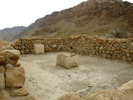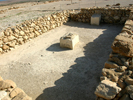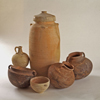Pantry

Introduction
The “pantry” adjoining the Assembly Hall contained a store of over a thousand dishes, which appear to have been buried following the earthquake in 31 BCE. These dishes are primarily undecorated types of cups, bowls, and plates, which would have been used by individual diners, as well as some serving utensils. The large number of individual dining utensils found in the this room has been interpreted as evidence of the Community’s concern with purity. Josephus found it worthy of mention that the custom of the Essenes was for each member to eat an individual serving of food from his own plate (War 2. 130), which differed from the usual contemporary practice where diners would dip individual pieces of bread into a common serving bowl. The rationale for the sectarian practice would likely have been to prevent inadvertent transmission of impurity. See Ritual Purity.
Qumran Pottery
Pottery is the basic tool of the archaeologist. Pottery types can serve as indicators to the provenance and the lifestyle of those who used the Qumran site. Analysis of the abundant pottery found at Qumran has prompted discussion about whether the ceramic finds are particularly distinctive, as compared to pottery found at other sites.
Long-time Qumran archaeologist Magen Broshi has argued that the presence of a potters’ workshop with two kilns , which was operational throughout the settlement of Qumran, indicates that the Community produced its own pottery, which he explained as reflecting their concerns about purity. More recently, archaeologists Yitzhak Magen and Yuval Peleg, who have challenged the consensus view of Qumran as a religious settlement, have suggested that the site functioned as a pottery factory, manufacturing goods for sale in the area. They point to the proximity of the “pantry” to the potters’ workshops to offer an alternative identification of this area, as a store-room for manufactured products.
The ceramic artifacts from Qumran have been analyzed by a process called NAA, neutron activation analysis, to determine the origins of the clay used in their manufacture. Only about a third of the vessels were made from clay found locally at Qumran. It has been observed, however, that this data does not actually prove the location where the vessels were manufactured, since clay could have been brought from Jericho, Jerusalem, or elsewhere, as raw material for production in the Qumran workshops. An additional result of the NAA has been to corroborate the association between the settlement of Khirbet Qumran and the scrolls caves, since the pottery from each is of similar chemical composition.
Jodi Magness has argued for the distinctiveness of the pottery from Qumran. Probably the most dramatic specimens of “Qumran pottery” are the familiar cylindrical jars in which the first scrolls from Cave 1 are reported to have been found, as well as their bowl-shaped lids, which have served as the model for the domed roof of the the Shrine of the Book at the Israel Museum. Cylindrical jars were found both in the caves and in the Qumran settlement; they are abundant at Qumran but not at other Judean sites of the period. Some similarly shaped vessels were found in the contemporary sites of Jericho and at Masada, indicating that they were a regional type. But these vessels are rare in the neighboring sites, and numerous at Qumran. The shape of the vessels has been explained as a reflection of the community’s strict concern with purity regulations. As compared to the standard “bag-shaped” jars common at other sites, the cylindrical shape of the Qumran jars would have been more conducive to maintaining the purity of foods and liquids during transfer between vessels. Magness further suggests that the distinctive shape would have come to be recognized as a sign that the contents were subject to the highest standards of purity regulations.
Although some of the pottery types at Qumran are anomalous, there are also many vessels that are similar in shape to those found at contemporary Judean sites such as Herodium and Jerusalem. Magness notes, however, that even in these cases, “the vessels differ in their fabric (clay) and surface treatment” (The Archaeology of Qumran and the Dead Sea Scrolls, p. 75). One of the distinctive attributes of the ceramic corpus of Qumran is the “conspicuous absence” of pottery types that are found in contemporary sites. There are no foreign imports, for example. Also absent, or rare, is a particular type of fine tableware called “Eastern Sigillata A” (ESA). Instead, there are some examples of vessels that seem to be locally-produced imitations of this style. In general, the pottery at Qumran is simple and undecorated, which contrasts with the greater variety and richness of pottery from other sites.
More Info
- Yitzhak Magen and Yuval Peleg, “The Qumran Excavations 1993-2004 preliminary report“
- Jodi Magness, “What do Pottery and Architecture Tell Us about Qumran,” in The Archaeology of Qumran and the Dead Sea Scrolls(Grand Rapids; Eerdmans, 2002), 73-104.


